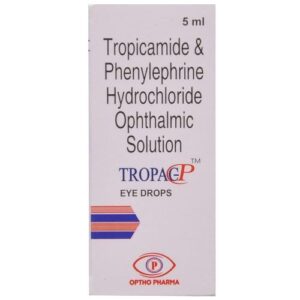TROPICAMIDE + PHENYLEPHRINE
Tropicamide: Tropicamide is a medication primarily used as a mydriatic and cycloplegic agent. It is commonly used in ophthalmology to dilate the pupil for eye examinations, including retinal examination, refraction, and funduscopy.
The mechanism of action of tropicamide involves blocking the action of acetylcholine at muscarinic receptors in the iris sphincter muscle and ciliary muscle. By inhibiting the parasympathetic stimulation of these muscles, tropicamide causes pupillary dilation (mydriasis) and paralysis of accommodation (cycloplegia).
The standard dose of tropicamide for adults is 1 or 2 drops (0.5% solution) in the eye(s) to be dilated. The effect usually occurs within 20-40 minutes and lasts for approximately 4-8 hours. In children, a lower concentration (0.25%) is often used.
Common side effects of tropicamide include temporary stinging or burning sensation in the eye upon application. It can also cause increased intraocular pressure, resulting in potential complications in individuals with narrow-angle glaucoma. Other possible side effects include blurred vision, sensitivity to light, dry mouth, and increased heart rate. These side effects are generally mild and resolve spontaneously within a few hours.
Although tropicamide is considered safe, it is important to inform healthcare professionals about any existing eye conditions, allergies, or other medications being taken to ensure its safe use.
Phenylephrine: Phenylephrine is a medication primarily used to relieve nasal congestion and is available in various forms such as nasal sprays, eye drops, and oral tablets. It is commonly used to treat symptoms of allergies, hay fever, and the common cold.
Phenylephrine works by constricting the blood vessels in the nasal passages, reducing the swelling and congestion, which in turn helps to relieve nasal stuffiness. It belongs to a class of medications known as alpha-agonists.
The dose of Phenylephrine can vary depending on the form in which it is taken. For nasal congestion relief, a typical dose of nasal spray is 2-3 sprays per nostril every 4 hours. For oral tablets, the recommended dose is usually 10-20 mg every 4 hours as needed. It is important to follow the instructions provided by the healthcare provider or the instructions on the packaging.
Common side effects of Phenylephrine may include a temporary burning or stinging sensation in the nose, sneezing, increased heart rate, increased blood pressure, headache, dizziness, and difficulty sleeping. It is important to note that these side effects are usually mild and temporary. However, if you experience severe side effects such as chest pain, difficulty breathing, or allergic reactions like rash, swelling, or itching, it is advisable to seek immediate medical attention.
It is worth mentioning that Phenylephrine should be used cautiously in individuals with certain medical conditions such as hypertension (high blood pressure), heart disease, thyroid problems, and diabetes. It may also interact with other medications, so it’s vital to inform your healthcare provider about all the medications you are currently taking before starting Phenylephrine.
In conclusion, Phenylephrine is a medication used to relieve nasal congestion. It works by constricting blood vessels in the nasal passages, reducing swelling and congestion. It is available in various forms and can have mild side effects like increased heart rate and blood pressure. Proper dosage and use should be followed, and it is always advisable to consult with a healthcare professional before starting any new medication.

